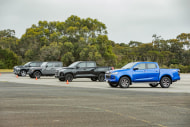
What does GCM mean?
Gross combination mass, or GCM, is yet another important weight consideration for anyone who plans to tow anything.
Gross combination mass, or GCM, is yet another important weight consideration for anyone who plans to tow anything.
It is, simply, the maximum weight allowed for your vehicle and trailer combined, and it is determined by the manufacturer of the tow vehicle.
The NSW Centre for Road Safety describes it as “the maximum combined mass of your loaded tow vehicle and your loaded caravan hitched together”.
So, it’s clear you need to know the weight of your vehicle, and the weight of the trailer you’re towing behind it.
Let’s consider a real-world scenario.
An Isuzu D-Max LS-M Crew Cab auto 4x4 pick-up has a gross combination mass of 6000kg, which is actually quite a lot for a ute of this type. And this particular Isuzu ute has a kerb weight or kerb mass of 2030kg. But, as mentioned above, as soon as you start adding weight to the vehicle you affect the amount of weight it can tow.
So, let’s say you load up the vehicle - which has a few hundred kilos of mods on it, with your theoretical family with older teens, and a tray full of stuff loaded to the canopy, and a roof rack setup with a roof tent. That pushes you right to the maximum gross vehicle mass of 3100kg.
That means that, while the advertising slogan for this ute and many others is all about the three-and-a-half-tonne towing capacity, you’re actually left with just 2900kg of towing capacity.
Leave the teens, and their stuff - including the rooftop tent - at home and save yourself, say, 400 kilos, and you end up back with a towing capacity of 3300kg.
So while towing capacity is a big consideration for buyers, your ute’s gross combination mass arguably needs to be an even bigger one.

More Tradie Ute Guide


